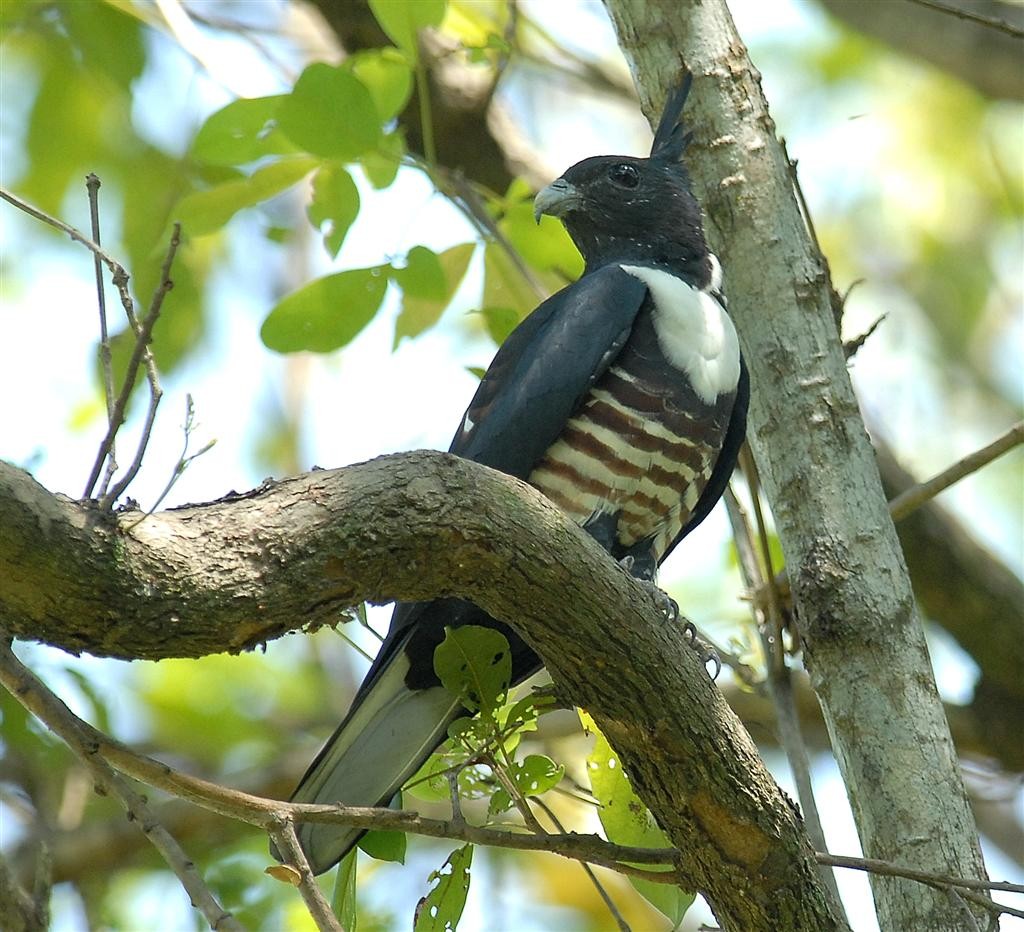Black Baza
A species of Bazas and Cuckoo-hawks Scientific name : Aviceda leuphotes Genus : Bazas and Cuckoo-hawks
Black Baza, A species of Bazas and Cuckoo-hawks
Botanical name: Aviceda leuphotes
Genus: Bazas and Cuckoo-hawks
Content
Description General Info
 Photo By NatureAtYourBackyard, Flickr User , used under CC-BY-2.0 /Cropped and compressed from original
Photo By NatureAtYourBackyard, Flickr User , used under CC-BY-2.0 /Cropped and compressed from original Description
The black baza is a small and distinctively coloured raptor; it ranges from 30 to 35 cm in length, a 66 to 80 cm wingspan and a weight of 168 to 224 g. When perched, the upright crest and contrasting patterns make it difficult to misidentify. The male has white scapulars, secondary coverts and on the secondaries. The female has white only on the scapulars and more chestnut bands on the underside unlike the few bands in the male. While flying, it is similar to a crow and is often seen in small groups or flocks during migration. During migration, they are gregarious at their roost. They are somewhat crepuscular and more active at dusk and in overcast weather. They feed mainly on insects by making aerial sallies. They may also pick insects off a leaf, the insects always seized with their feet. They have been observed to attempt capturing small birds such as wagtails by making dashes into flocks. They have been noted to join mixed-species foraging flocks. It has also been known to feed on the fruits of the oil palm. They are somewhat crepuscular in habit. The call is a "chu-weep" somewhat similar to the call of the large cuckoo-shrike. Other descriptions include a soft squeal or whistle and a shrill gull-like mewing. Like others in the genus Aviceda they have two tooth like indentations on the edge of the upper bill. Birds are said to have a disagreeable odour which has been said to be "bug-like". 
Size
35 cm
Nest Placement
Tree
Feeding Habits
Black Baza primarily consumes large insects such as grasshoppers, beetles, mantids, and moths. It also feeds on lizards, tree frogs, and occasionally small mammals and birds. Over 50% of the diet for nestlings is insect larvae. Uniquely, black Baza sometimes eats palm fruit nuts. It hunts from perches with short sallies, picking prey from foliage or ground, and may hunt in small flocks or hang upside-down to feed. Active during overcast conditions, dawn, and dusk, black Baza can show gregarious behavior.
Habitat
The black Baza primarily resides in tropical deciduous or evergreen forests, often frequenting areas with secondary growth and bamboo. It prefers environments with clearings and vicinity to wide streams. During migration and winter, when it becomes more social, the black Baza can also be found in mangroves, orchards, village gardens, and agricultural fields, particularly where rice is cultivated. It is known to roost communally at traditional sites that may be used repeatedly over the years.
Dite type
Carnivorous
General Info
Feeding Habits
Bird food type
Distribution Area
This species is found in Southeast Asia and parts of South Asia. They are migratory in parts of their range. Migratory birds may be seen in large numbers at some locations such as Chumphon in Thailand where they account for nearly 40% of the raptors on passage. In some parts of Hong Kong, they have established themselves in recent times changing from summer visitors to residents in small numbers. In southern India the species is regularly reported in winter mainly from the Western Ghats (breeding records have been questioned), Eastern Ghats (mainly on spring passage) and known to breed in northeastern India and Burma. Winter records of the species include stray occurrences in or near metropolitan areas such as the Guindy National Park in Chennai, near Trivandrum and Bangalore. More recent studies have suggested that the species may be a regular winter visitor in the eastern part of peninsular India, and not just a passage migrant. Individuals have also been noted at Point Calimere. The birds in northeastern India begin to breed in April. Both sexes take part in nest building, incubation, brooding and feeding. The nest is a firm platform of thin sticks with a central depression and lined with grass, fiber and overlaid with green leaves. The eggs take about 26–27 days to hatch. Insects are the predominant food of the chicks. 
Species Status
Not globally threatened.

 Photo By NatureAtYourBackyard, Flickr User , used under CC-BY-2.0 /Cropped and compressed from original
Photo By NatureAtYourBackyard, Flickr User , used under CC-BY-2.0 /Cropped and compressed from original